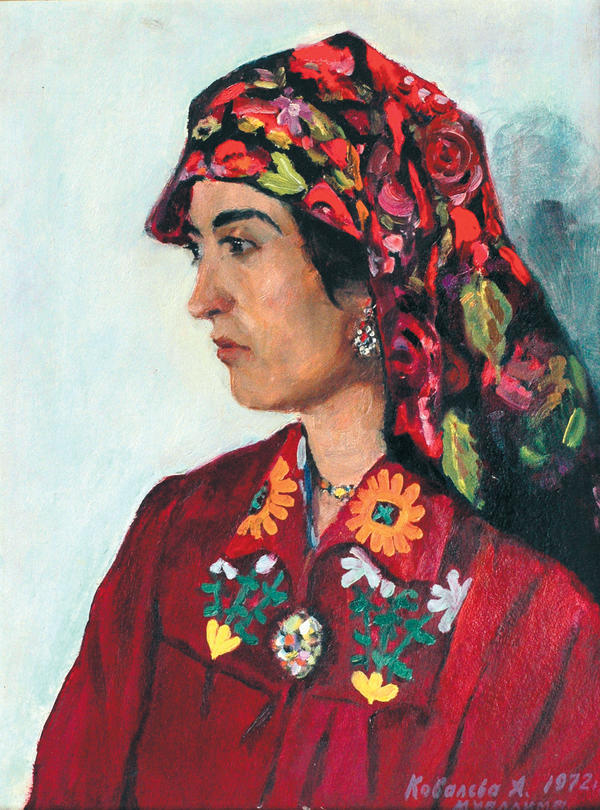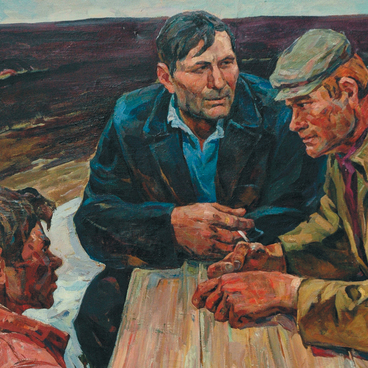The Portrait of muallima is the work of the talented artist Anna Vasilievna Kovaleva, who lived and worked in Tajikistan in Soviet times. Kovaleva was a professional geologist and painted in her free time.
This painting depicts a beautiful young woman, ‘muallima’, which means ‘teacher’ in Tajik. Before Tajikistan joined the USSR, the local education system lagged behind. As a legacy of Islamic culture, education took place mainly at mosques and was generally religious in nature. The Russian Empire made attempts to introduce Russian-native schools in Tajikistan, of which there were 89 by 1911. Unlike traditional religious schools (maktabs), imperial schools taught secular sciences, and classes followed pre-determined programmes and timetables. In the end, however, the schools did not bring the desired results.
In the Tajik SSR, the reorganization of the education system began with the elimination of mass illiteracy among the population. To this end, elementary schools and boarding schools were created for children along with Literacy schools for adults. In the 1930s, an extraordinary Commission and the Down with Illiteracy society were created in the republic to combat illiteracy. Women were given access to education for the first time in the country’s history. First, they studied in women’s schools and classes, and then some of them continued on as instructors and teachers. Many women became organizers of the literacy movement. Pedagogical courses and teacher training schools were created to train teachers, two pedagogical institutes were opened in Stalinabad and Khujand, as well as the Tajik Institute of Education in Tashkent.
The Portrait of muallima was painted in 1972, when education in Tajikistan was already moving forward and bearing fruit. The woman is depicted in bright traditional Tajik clothing. The teacher is wearing a dress with a vertical neckline decorated with embroidery — clothes of this kind were usually worn in Tajikistan by married women. Muallima’s head is covered with a colourful shawl — an integral part of the image of traditional women’s clothing in Tajikistan. Bright jewellery — massive earrings, beads, a brooch made of multi-coloured stones — are national features.
The portrait is interesting for the contrast in its combination of traditions and innovations. We have before us here a modern, educated woman dressed in traditional, indigenous clothing.
This painting depicts a beautiful young woman, ‘muallima’, which means ‘teacher’ in Tajik. Before Tajikistan joined the USSR, the local education system lagged behind. As a legacy of Islamic culture, education took place mainly at mosques and was generally religious in nature. The Russian Empire made attempts to introduce Russian-native schools in Tajikistan, of which there were 89 by 1911. Unlike traditional religious schools (maktabs), imperial schools taught secular sciences, and classes followed pre-determined programmes and timetables. In the end, however, the schools did not bring the desired results.
In the Tajik SSR, the reorganization of the education system began with the elimination of mass illiteracy among the population. To this end, elementary schools and boarding schools were created for children along with Literacy schools for adults. In the 1930s, an extraordinary Commission and the Down with Illiteracy society were created in the republic to combat illiteracy. Women were given access to education for the first time in the country’s history. First, they studied in women’s schools and classes, and then some of them continued on as instructors and teachers. Many women became organizers of the literacy movement. Pedagogical courses and teacher training schools were created to train teachers, two pedagogical institutes were opened in Stalinabad and Khujand, as well as the Tajik Institute of Education in Tashkent.
The Portrait of muallima was painted in 1972, when education in Tajikistan was already moving forward and bearing fruit. The woman is depicted in bright traditional Tajik clothing. The teacher is wearing a dress with a vertical neckline decorated with embroidery — clothes of this kind were usually worn in Tajikistan by married women. Muallima’s head is covered with a colourful shawl — an integral part of the image of traditional women’s clothing in Tajikistan. Bright jewellery — massive earrings, beads, a brooch made of multi-coloured stones — are national features.
The portrait is interesting for the contrast in its combination of traditions and innovations. We have before us here a modern, educated woman dressed in traditional, indigenous clothing.



